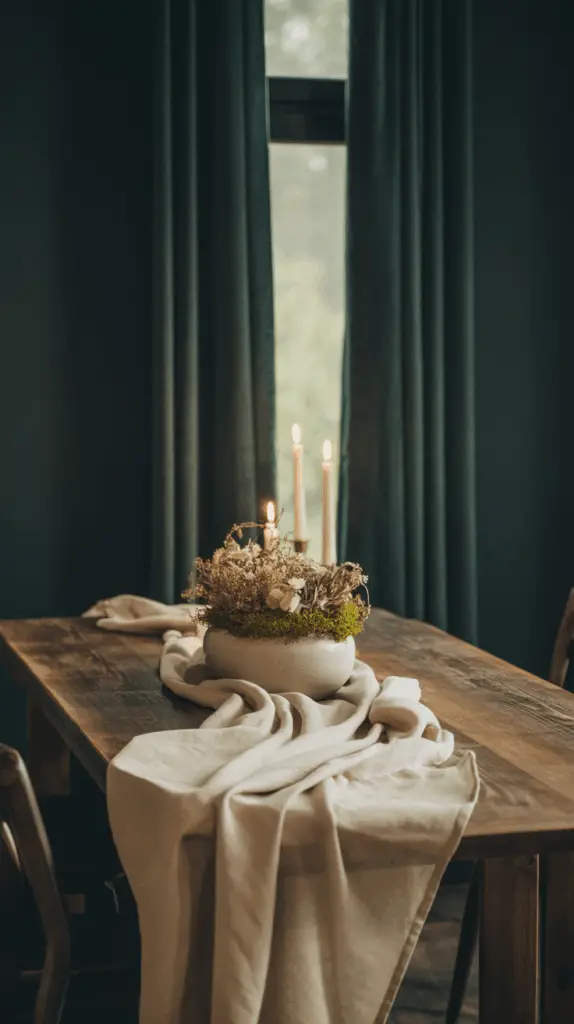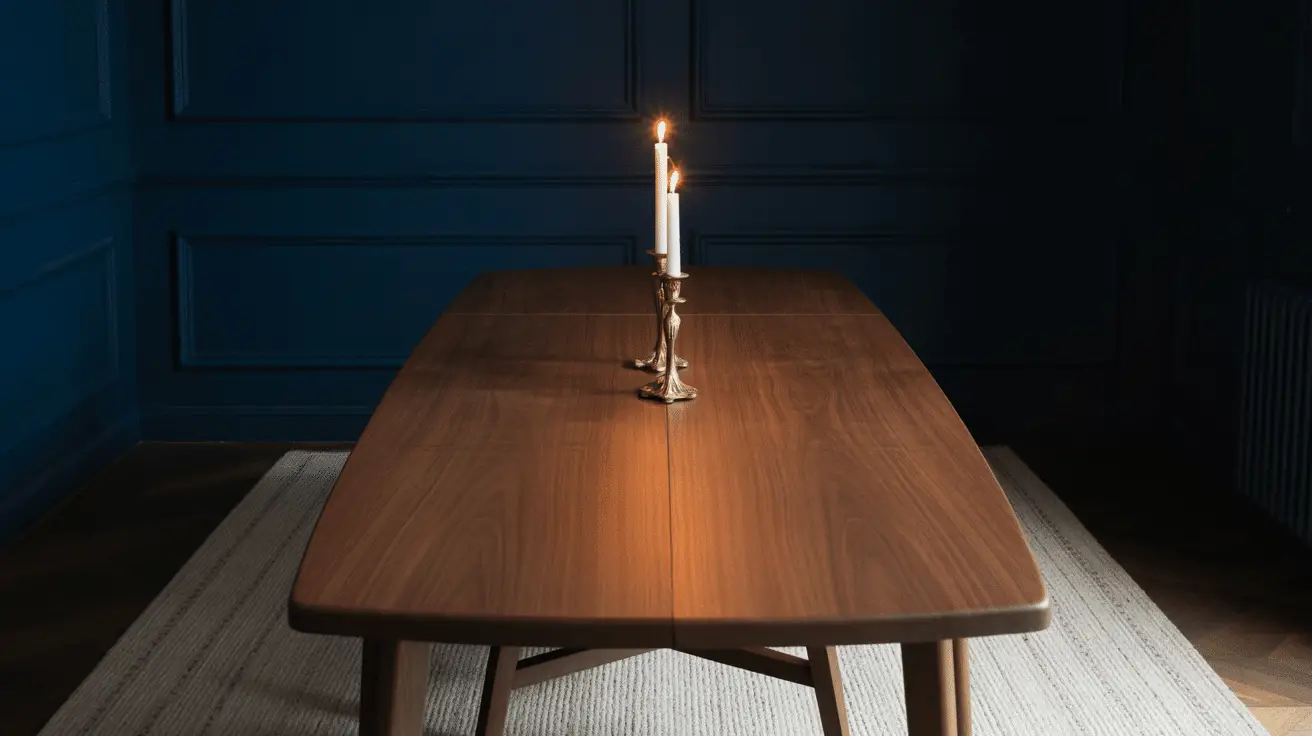Cozy Moody Dining Room Ideas to Elevate Your Space with Elegant Atmosphere
Table of Contents
Introduction
Picture this: candlelight flickers against a backdrop of deep charcoal walls, a velvet curtain softly drapes to the floor, and a warm, rustic table invites you in for a lingering dinner. Moody dining rooms aren’t just a passing trend—they’re a sophisticated lifestyle choice. In fact, designers and homeowners alike are embracing this aesthetic for its ability to create spaces that feel both intimate and elevated.
Why does a moody dining room matter? Because it changes how a space feels and functions. A cozy, dramatic dining area can turn everyday meals into indulgent experiences, ideal for dinner parties, slow Sunday breakfasts, or a quiet glass of wine. The magic lies in the rich colors, layered textures, and thoughtful lighting that transform ordinary rooms into extraordinary sanctuaries.
In this article, we’ll explore how to master the cozy moody dining room look—from paint colors and lighting to furniture, fabrics, and decorative details. Whether you’re working with a compact corner or a grand formal space, you’ll find ideas to suit your style and scale. Expect actionable tips, visual inspiration, and creative combinations that will help you turn your dining room into a soulful, welcoming retreat.
Start with a Deep, Rich Color Palette
The foundation of any cozy moody dining room begins with the right color palette. Deep hues create an enveloping atmosphere, setting the tone for a space that feels intimate and layered. Think inky blues, forest greens, aubergines, slate grays, or even black. These tones don’t just add depth—they ground the room, making it feel anchored and calm.
Choose a wall color that defines the mood. Matte or eggshell finishes are ideal for moody aesthetics because they absorb light and reduce glare, adding to the room’s softness. If you’re hesitant to go all-in, consider an accent wall or painted wainscoting for a dramatic touch without overwhelming the space.
The key is to balance dark walls with complementary elements. Warm metallics like brass or gold, wood tones, and natural fibers prevent the room from feeling too cold or stark. Deep doesn’t mean dreary—it’s all about intentional contrast.
Color Palette Ideas Table:
| Primary Wall Color | Accent Pairings | Mood Created |
| Charcoal Gray | Brass, light oak, cream linens | Elegant and modern |
| Navy Blue | Warm gold, tan leather, marble | Classic and timeless |
| Forest Green | Antique brass, dark walnut, linen | Organic and grounding |
| Burgundy | Aged bronze, beige velvet, matte black | Dramatic and romantic |
Layer Lighting for Warmth and Drama
Lighting is the heart of a moody dining room. It’s what transforms dark tones into a welcoming glow rather than a shadowy cave. Layered lighting allows you to create atmosphere and function, offering flexibility for everything from romantic dinners to late-night conversations.
Begin with a statement overhead light, such as a vintage-inspired chandelier or a modern pendant with soft diffusion. Choose warm bulb temperatures (around 2700K) to enhance the cozy ambiance. Then, add accent lighting—wall sconces, table lamps, or even battery-operated candles—to bring the corners of the room to life.
Dimmer switches are essential. They give you full control over the mood, allowing you to adjust brightness to match the moment. Finally, consider incorporating reflective surfaces like antique mirrors or metallic accessories to bounce light gently and enhance the glow.
Lighting Layer Breakdown:
| Layer | Purpose | Design Tip |
| Overhead Fixture | Ambient light and focal point | Choose warm-toned bulbs, not daylight white |
| Wall Sconces | Accent lighting and depth | Install on either side of art or mirrors |
| Table Lamps/Candles | Intimate and movable lighting | Use with dimmers or warm flicker LED lights |
| Reflective Surfaces | Bounce and diffuse light subtly | Position to reflect natural or candlelight |

Incorporate Textural Elements for Depth and Coziness
One of the secrets to achieving a truly cozy moody dining room lies in texture. When working with darker tones, texture adds dimension and prevents the space from feeling flat. The interplay of soft, rough, smooth, and natural materials can create a sensory-rich environment that invites you to linger.
Start with textiles—think velvet drapes that pool on the floor, linen tablecloths, or boucle dining chairs. These add a tactile richness that complements deep color palettes. Natural wood furniture with visible grain, vintage rugs, and handcrafted ceramics also bring warmth and authenticity.
Layer different materials strategically. Combine metal finishes like aged brass or black iron with stone, wood, and soft textiles. The goal is to create contrast not just in color, but in touch and feel. A room that looks inviting is nice; one that feels inviting is unforgettable.
Texture Layering Guide:
| Material | Function | Best Pairings |
| Velvet | Adds softness and luxury | Contrasts beautifully with matte walls |
| Linen | Breathable and natural feel | Works well with rustic wood |
| Wood (raw or stained) | Grounds and warms the space | Pairs with all moody hues |
| Ceramic/Stoneware | Adds artisanal, organic element | Complements metal accents and soft textiles |
Add Dramatic Furniture that Makes a Statement
Furniture in a moody dining room should feel grounded, inviting, and character-rich. Think less “matching set” and more “curated story.” The dining table often acts as the anchor, so opt for pieces with a strong silhouette—a reclaimed wood farmhouse table, a marble-topped modern base, or a chunky black-stained oak design.
Chairs are an opportunity to add softness and elegance. Upholstered seats in velvet, leather, or textured weaves create contrast and comfort. Don’t be afraid to mix styles—combining vintage chairs with a modern table, or vice versa, adds depth and personal flair.
Sideboards, hutches, or shelving can also play a role, especially when styled with intention. Use these surfaces to showcase items that add richness to the scene—stacked books, taper candles, sculptural bowls, or framed art. It’s about balancing form and function.
Furniture Styling Inspiration:
| Furniture Piece | Material/Style | Impact on Mood |
| Dining Table | Reclaimed wood, dark-stained oak | Grounds the room, adds rustic depth |
| Dining Chairs | Velvet, leather, vintage mix | Introduces texture and comfort |
| Sideboard/Hutch | Painted wood, metal-accented | Offers storage and visual interest |
| Centerpiece Elements | Stone bowl, fresh foliage | Adds life and sculptural elegance |
Bring in Nature with Moody Greenery and Organic Decor
Even the darkest, moodiest spaces benefit from touches of nature. Greenery—especially in rich, forest tones—provides a fresh contrast to the darker palette. Instead of traditional florals, opt for oversized branches, potted ferns, eucalyptus, or dried florals in earthen vases.
Use natural materials in your decor—wicker baskets, stone or terracotta pots, and wooden candleholders add balance and warmth. Organic shapes and asymmetry also work beautifully in moody spaces. Think sculptural centerpieces or imperfect pottery that tells a story.
This approach not only softens the drama of the room but brings in a sense of serenity and connection to the natural world. It’s an easy and affordable way to make the space feel lived-in, loved, and alive.
Natural Decor Elements Table:
| Item Type | Material/Style | How It Enhances the Room |
| Greenery | Ferns, eucalyptus, dark foliage | Adds softness and a sense of freshness |
| Vessels | Terracotta, stoneware, glass | Organic texture and sculptural beauty |
| Centerpieces | Driftwood, moss, seasonal fruit | Earthy, seasonal, and grounding |
| Accent Details | Linen napkins, woven placemats | Adds tactile warmth to tabletop styling |
Display Art and Accessories That Tell a Story
Art plays a powerful role in moody spaces. It helps reinforce the tone of the room while reflecting your personal aesthetic. Large-scale abstract paintings, vintage oil portraits, or framed black-and-white photography all work beautifully in cozy moody dining rooms.
Choose art with deeper tones or rich colors that harmonize with your palette. Gold or black frames add a refined touch, especially when hung symmetrically or leaned casually on a sideboard. For an even more immersive experience, consider gallery walls or layered art—leaned, stacked, and propped for a collected, evolved look.
Accessories should follow the same intentionality. A sculptural candleholder, a stack of hardcover books, or a bowl of seasonal fruit can add richness without cluttering the space. Edit ruthlessly—less is often more in moody design, where every piece has weight and purpose.
Art & Accessory Style Matrix:
| Item Type | Style Guide | Visual Effect |
| Wall Art | Moody abstracts, portraits, monochrome | Deepens tone and adds personality |
| Table Decor | Candles, books, ceramics | Creates layered visual interest |
| Wall Mirrors | Aged gold or black frames | Expands light and space subtly |
| Textural Accents | Clay vases, rustic wood bowls | Adds natural texture and balance |
Conclusion
Designing a cozy moody dining room is about more than paint and lighting—it’s about creating an emotional experience. From the rich color palette to the layered lighting, textured materials, and curated details, every element should serve a purpose: to welcome, to calm, and to inspire. When done right, a moody dining room becomes a destination within your home—a place to gather, reflect, and savor the moment. Whether you’re entertaining guests or enjoying quiet solitude, these ideas will help you craft a space that feels effortlessly elevated and deeply personal.

